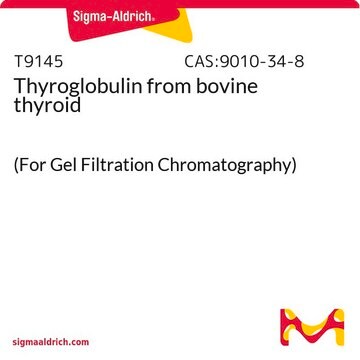T1001
Thyroglobulin from bovine thyroid
powder, ≥90% (agarose gel electrophoresis)
Synonym(s):
Globulins thyro, Thyractin
About This Item
Recommended Products
biological source
bovine thyroid
Quality Level
assay
≥90% (agarose gel electrophoresis)
form
powder
mol wt
~670 kDa
composition
Iodine, ≥0.20%
nitrogen analysis
13.0-16.0% total
ash
≤4%
solubility
H2O: 20 mg/mL
UniProt accession no.
Storage temp.
−20°C
Gene Information
cow ... TG(280706)
Looking for similar products? Visit Product Comparison Guide
Application
Biochem/physiol Actions
Storage Class
11 - Combustible Solids
wgk_germany
WGK 3
flash_point_f
Not applicable
flash_point_c
Not applicable
ppe
Eyeshields, Gloves, type N95 (US)
Choose from one of the most recent versions:
Certificates of Analysis (COA)
Don't see the Right Version?
If you require a particular version, you can look up a specific certificate by the Lot or Batch number.
Already Own This Product?
Find documentation for the products that you have recently purchased in the Document Library.
Customers Also Viewed
Our team of scientists has experience in all areas of research including Life Science, Material Science, Chemical Synthesis, Chromatography, Analytical and many others.
Contact Technical Service













